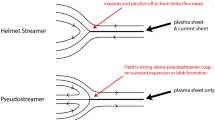Summary
Using values of d, γmin, and γmax that Van Riper (1978) has found most promising for a hydrodynamic envelope ejection, we have shown that even a small amount of rotation in the initial core can stop its collapse before nuclear densities are reached. We expected χi > 0.02 to produce significant deviations from a spherically symmetric collapse, but have found that χi as much as ten times smaller than this will not allow the core to reach densities as high as in the spherical collapse. In no case, however, does the core flatten very much, nor does the value of β become very large. Low final β's preclude the formation of an axisymmetric torus. They also indicate that deformation of an iron core into a triaxial configuration or fragmentation of the core during its collapse is an extremely unlikely event. (Note: Classically, β must exceed 0.27 before a dynamic instability to non-axisymmetric perturbations is encountered.)
The small degree of flattening of the core also suggests that the reduced moment of inertia I of the core will always be relatively small in magnitude and hence that the third time derivative of I, which is proportional to the energy emitted in gravity wave radiation, will not be very significant. Numerically calculated estimates of I- during some of these model evolutions supports this suspicion. If the γmin and used here are found to be realistic values after the detailed physics of the core collapse is well understood, it is clear that gravitational radiation from a core collapse will be difficult to measure.
Finally, we should point out that it is the relatively large values of Ymin (near 4/3) combined with values of d near unity that (a) prevented the core from flattening significantly in these models and (b) prevented the core from reaching high β configurations. If “realistic” values of either one (or both) of these parameters are found to be much smaller in more complete models of the core collapse, then the core will have to become flatter (and denser) before pressure gradients will support it along the rotation axis. All of the conclusions drawn here would be modified accordingly under those circumstances. It should also be noted that in general relativistic models, the critical Γ for spherical collapse is somewhat larger than 4/3 (Van Riper, 1979). Therefore, we predict that when fully general relativistic core collapses are performed including rotation, a given choice of γmin and βi will produce a slightly flatter and slightly denser core than the corresponding model that has been presented here.
Similar content being viewed by others
References
Boss, A. P.: 1980a, Astrophys. J. 236, p. 619.
Boss, A. P.: 1980b, Astrophys. J. 237, p. 563.
Chia, T. T., Chau, W. Y., and Henriksen, R. N.: 1977, Astrophys. J. 214, p. 576.
LeBlanc, J. M., and Wilson, J. R.: 1970, Astrophys. J. 161, p. 541.
Müller, E., Różyczka, M., and Hillebrandt, W.: 1980, Astron. Astrophys. 81, p. 288.
Novikov, I. D.: 1975, Soviet Astr. -AJ 19, p. 398.
Ruderman, M.: 1972, Ann. Rev. Astron. Astrophys. 10, p. 427.
Saenz, R. A. and Shapiro, S. L.: 1978, Astrophys. J. 221, p. 286.
Saenz, R. A. and Shapiro, S. L.: 1979, Astrophys. J. 229, p. 1107.
Shapiro, S. L.: 1977, Astrophys. J. 214, p. 566.
Shapiro, S. L.: 1979, Sources of Gravitational Radiation, ed. L. L. Smarr, Cambridge Univ. Press, Cambridge, p. 355.
Thuan, T. X., and Ostriker, J. P.: 1974, Astrophys. J. Letters 191, p. L105.
Tohline, J. E.: 1980a, Astrophys. J. 235, p. 866.
Tohline, J. E.: 1980b, Astrophys. J. 236, p. 160.
Van Riper, K. A.: 1978, Astrophys. J. 221, p. 304.
Van Riper, K. A.: 1979, Astrophys. J. 232, p. 558.
Author information
Authors and Affiliations
Rights and permissions
About this article
Cite this article
Tohline, J.E., Schombert, J.M. & Boss, A.P. The effect of rotation on the hydrodynamics of stellar collapse. Space Sci Rev 27, 555–561 (1980). https://doi.org/10.1007/BF00168349
Issue Date:
DOI: https://doi.org/10.1007/BF00168349




